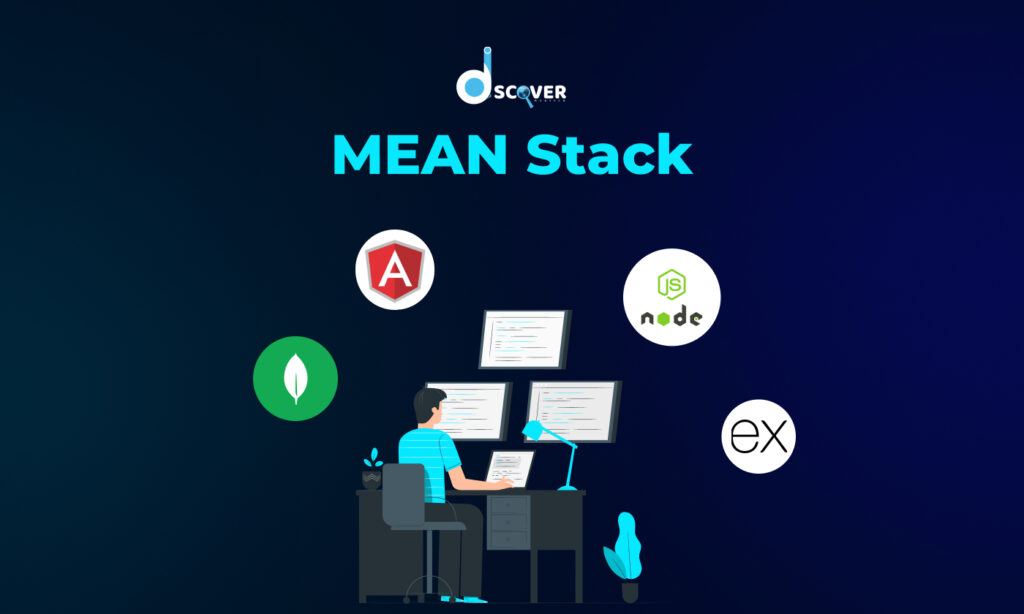
The MEAN stack is a group of technologies used to create modern web applications. It’s called a “full-stack” because it uses JavaScript for both the front-end and back-end development. The MEAN stack consists of four main technologies: MongoDB, Express.js, Angular, and Node.js. These work together to build fast and scalable web apps.
- MongoDB: A database that stores data in a flexible format, making it easy to handle different types of data.
- Express.js: A simple framework for building web servers and APIs, which helps in managing backend tasks.
- Angular: A front-end framework that helps developers create interactive user interfaces for websites.
- Node.js: A tool that lets you run JavaScript on the server side, managing server requests and responses.
Components of MEAN Stack
The MEAN stack is made up of four key technologies, each playing an important role in creating web applications:
- MongoDB: The NoSQL Database
MongoDB is a flexible database that stores data in a simple, JSON-like format. It’s perfect for handling different types of data and is easy to scale as your app grows. - Express.js: The Web Application Framework
Express.js is a lightweight framework used to build web applications and APIs in Node.js. It makes creating backend applications easier by handling routing and requests quickly. - Angular: The Frontend Framework
Angular is a frontend framework that helps developers build dynamic, single-page applications. It provides tools for creating interactive and responsive user interfaces. - Node.js: The JavaScript Runtime
Node.js allows you to run JavaScript on the server side, making it fast and efficient for handling multiple tasks at once. It’s perfect for building scalable applications.
Advantages of Using MEAN Stack
The MEAN stack comes with several benefits that make it a great choice for developers. Here are some of the main advantages:
- Full JavaScript Development
With the MEAN stack, you can use JavaScript for both the front-end development and back-end development. This means you only need to know one language, which makes the development process faster and simpler. - Scalability and Performance
The MEAN stack is built for performance and scalability. MongoDB can handle large amounts of data, and Node.js allows your application to process many requests at the same time, making it ideal for high-traffic websites. - Real-time Data Processing
Node.js helps the MEAN stack handle real-time data processing, which is perfect for applications like live chats, notifications, and live updates, where information needs to be delivered instantly. - Open Source and Community Support
All the tools in the MEAN stack are open-source, meaning they are free to use and can be customized. Plus, each technology has a large community, offering plenty of support and resources to help developers.
How MEAN Stack Works Together
The tools in the MEAN stack work smoothly together to build fast and interactive web applications. Data is stored in MongoDB, a flexible database, and then passed to Angular, the frontend framework, where it’s shown to users in real time. On the backend, Node.js handles requests quickly, thanks to its ability to process multiple tasks at once. Express.js works alongside Node.js to manage HTTP requests, making sure the frontend and backend communicate smoothly. This flow of data from MongoDB to Angular, powered by Node.js and Express.js, ensures your web app runs efficiently and responds quickly.
When to Use MEAN Stack
The MEAN stack is perfect for building fast, real-time web applications where performance and scalability are important. It works well for single-page applications (SPAs), real-time chat apps, and collaborative tools that need constant data updates. If your project requires using one programming language (JavaScript) for both the front-end and back-end, the MEAN stack is a great fit. It’s also ideal for websites that need fast performance and responsive user interfaces, such as e-commerce platforms, social media sites, and content management systems.
MEAN Stack vs Other Tech Stacks
When you compare the MEAN stack with other tech stacks like LAMP and MERN, you’ll see that each one has its advantages depending on the project. LAMP (Linux, Apache, MySQL, PHP) is great for traditional websites, but MEAN is better for building modern, scalable web apps because it uses JavaScript throughout. MERN, on the other hand, swaps Angular for React, which focuses more on creating interactive user interfaces.
- MEAN Stack vs LAMP Stack: MEAN uses JavaScript for both the front-end and back-end, which makes development faster and more scalable. LAMP, however, uses different languages (PHP and MySQL), which can make it more complicated to manage.
- MEAN Stack vs MERN Stack: MEAN uses Angular, a complete framework for building complex apps, while MERN uses React, which is more focused on creating dynamic user interfaces. MERN is great for interactive apps but might not be as structured as MEAN for large-scale projects.
Final Thoughts
The MEAN stack is a great choice for building modern web applications because it’s fast, flexible, and efficient. Using JavaScript for both the front-end and back-end makes development quicker and easier. The stack offers great scalability, real-time data processing, and strong community support, making it ideal for high-performance projects. Whether you’re building a simple app or a large platform, the MEAN stack provides the tools you need to succeed. A MEAN stack developer can help you make the most of these powerful technologies to create efficient and scalable web applications.
Frequently Asked Questions (FAQ’s)
What do you MEAN by MEAN stack?
The MEAN stack is a JavaScript framework used to build scalable web applications. It stands for MongoDB, Express, Angular, and Node, which are the four core technologies that make up the stack. MongoDB is a NoSQL database designed for cloud-based applications.
Is MEAN or MERN better?
Both stacks can build modern, scalable applications. MEAN is a good option if your team is familiar with Angular and prefers a structured framework. However, if your team likes React.js for its flexibility and simplicity, MERN might be a better fit.
What is difference between full-stack and MEAN stack?
Full Stack developers work on both the frontend and backend, including APIs, while the MEAN stack is focused specifically on a set of frameworks: MongoDB, ExpressJS, AngularJS, and NodeJS.
When to use MEAN stack?
It’s a great option for building cloud-native applications due to its scalability and ability to handle multiple users at once. The AngularJS front-end framework also makes it perfect for creating single-page applications (SPAs) that provide all features and content on one page.
Is MEAN stack easy to learn?
One advantage of the MEAN stack is that it uses JavaScript across the entire stack, making it easier to learn and work with.


